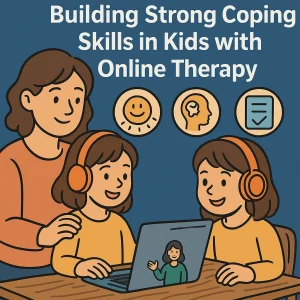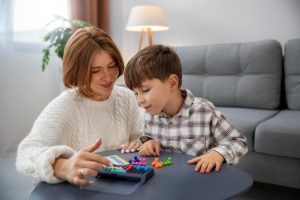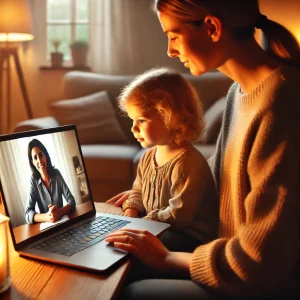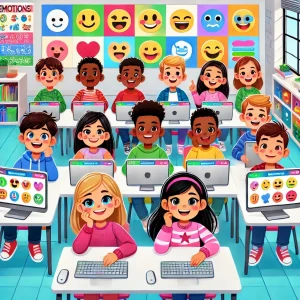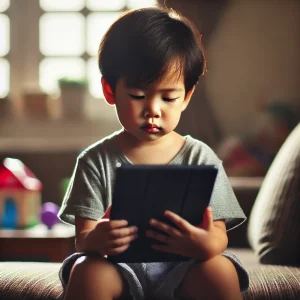7 Proven Behavioral Therapy Techniques for Kids
Last Updated: June 25, 2025
Is your child struggling with tantrums, defiance, or anxiety—and you’re not sure what to do next? You’re not alone. Many parents feel overwhelmed when their child shows challenging behavior, but there are proven strategies that can help. Behavioral therapy techniques are simple, science-backed tools that teach children how to manage emotions, follow directions, and build better habits—right from home.
In this guide, we’ll explore the most effective Behavioral therapy techniques for kids, explain how they work, and show you how to use them in everyday situations. Whether your child is dealing with anger outbursts, social difficulties, or attention issues, these techniques are easy to follow and designed for real-life parenting.
Let’s help your child grow with confidence—starting with the right tools and guidance you can trust.
Manage Your Child’s Behavior
Get expert help to manage tantrums, anger, or defiance. Online behavioral therapy that empowers better habits and emotional growth.
What is Behavioral Therapy?
Behavioral therapy is a type of treatment that helps children learn healthier ways to respond to their thoughts, emotions, and actions. At its core, Behavioral therapy focuses on encouraging positive behaviors and reducing negative ones by using consistent routines, praise, and structured activities.
In simple terms, Behavioral therapy teaches kids how to behave in more helpful ways at home, school, and with others. It works especially well for children who struggle with ADHD, autism, or anxiety, where Behavioral patterns can get in the way of learning, friendships, or daily routines.
The definition of Behavioral therapy centers on understanding how a child’s behavior is shaped by what happens before and after they act. Therapists help identify triggers and teach both the child and caregiver new strategies to handle difficult moments with more success.
Read More: Understanding Behavioral Therapy: A Simple Guide for Parents
How Does It Help Children?
- It gives children tools to manage emotions and follow instructions better.
- It helps reduce tantrums, aggression, or withdrawal.
- It builds stronger social skills through rewards and role-play.
- It supports caregivers by teaching consistent strategies at home.
Behavioral Therapy vs. Cognitive Behavioral Therapy (CBT)
While Behavioral therapy focuses directly on actions and responses, Cognitive Behavioral Therapy (CBT) also addresses how thoughts affect those behaviors. CBT is more common in older children who can talk about their feelings. In contrast, Behavioral therapy is perfect for younger kids who learn best through doing and observing.
Pediatricians and child psychologists often recommend Behavioral therapy as a first-line treatment for kids with ADHD, autism spectrum disorder, or anxiety-related challenges. It’s practical, easy to apply in real life, and backed by decades of research.

How Behavioral Therapy Works for Children Ages 3 to 12
Understanding how behavioral therapy works can help parents guide their children through emotional and developmental challenges. Behavioral therapy for children aged 3 to 12 focuses on improving behavior by identifying triggers, teaching new skills, and reinforcing positive actions.
1. Addressing Challenging Behavior
Children often act out when they feel overwhelmed, anxious, or misunderstood. Behavioral therapy doesn’t just manage the outbursts—it gets to the root of the problem. Therapists observe a child’s daily environment and reactions to pinpoint patterns that lead to disruptive behavior. Behavioral interventions for kids help them learn appropriate ways to express emotions, follow directions, and handle frustration. This approach builds emotional resilience and self-control.
2. Role of Positive Reinforcement and Structured Routines
Positive reinforcement forms the backbone of behavioral therapy. When a child receives praise, a token, or a small reward for good behavior, they feel encouraged to repeat it. Over time, this method reshapes negative patterns into constructive habits.
Therapists also introduce structured routines that help children predict what comes next. Clear expectations reduce anxiety and give kids a sense of control. Whether it’s transitioning from playtime to mealtime or following classroom rules, routines support consistency and emotional security.
3. Understanding the ABC Model: Antecedent–Behavior–Consequence
Therapists use the ABC model to break down behavior into three parts:
- Antecedent – What happens right before the behavior?
- Behavior – What action does the child take?
- Consequence – What follows the behavior?
By identifying these steps, parents and therapists can change either the antecedent (like removing a trigger) or the consequence (like reinforcing positive outcomes). This model helps children make connections between their actions and the results, promoting accountability and learning.
Behavioral therapy for children teaches them to make better choices, manage feelings, and respond to life’s challenges with confidence.
7 Proven Behavioral Therapy Techniques Parents Can Use at Home
Supporting your child’s emotional and behavioral growth doesn’t always require a clinic. Many Behavioral therapy techniques work well right at home. With consistency and a few simple tools, you can guide your child through challenges and build positive habits.
Here are 7 parent-led Behavioral therapy strategies you can start using today.
1. Positive Reinforcement
What it means and how to implement it
Positive reinforcement rewards a child for showing the behavior you want to see. It encourages them to repeat that action.
For example, if your child shares their toy with a sibling, you could say, “I love how you shared your toy. That was kind.” This praise helps reinforce good behavior.
Rewards vs. bribes: knowing the difference
A reward comes after the behavior. A bribe happens before. You don’t say, “If you clean your room, I’ll give you a candy.” Instead, say, “You cleaned up so nicely! Let’s pick a fun sticker for your chart.”
Keep it simple, sincere, and immediate.
2. Token Economy System
Using tokens, stars, or points to shape behavior
A token system helps children connect effort with reward. Each time your child completes a task—like brushing their teeth or putting away toys—they earn a token.
Set a goal: “Five stars equals a movie night.” This system builds motivation and teaches delayed gratification. You can use coins, stars, stickers, or even marbles in a jar.
Track progress visually so kids can see how close they are to their reward.
3. Modeling (Behavioral Rehearsal)
How kids learn by watching you
Children learn by copying. If you want your child to stay calm when frustrated, show them how. Say out loud, “I’m feeling upset, so I’m going to take a deep breath.”
Practice social or emotional skills together. Role-play scenarios like greeting someone or asking for help. Your child sees your example and learns the right response.
Consistent modeling builds real-life skills over time.
4. Prompting and Cueing
Helping a child respond correctly without doing it for them
Prompting gives your child a gentle reminder about what to do. If your child forgets to say “thank you,” a whisper like “What do we say?” helps nudge them in the right direction.
Use visual cues like a stop sign on the wall or a checklist on the fridge. These reminders support independence while reducing power struggles.
Gradually fade your prompts to encourage your child to act without reminders.
5. Time-Outs and Logical Consequences
When and how to use time-outs effectively
A time-out gives a child space to calm down, not to punish. Keep it short and in a safe space. Set a timer, stay nearby, and explain calmly why it’s happening.
If your child throws a toy, the logical consequence could be taking a break from that toy. These moments teach cause and effect.
Alternative strategies to punishment
Instead of yelling or scolding, try redirection, choices, or offering a calming activity. Children respond better to firm yet respectful guidance.
6. Social Skills Training at Home
Teaching turn-taking, eye contact, and managing frustration
Use playtime as a teaching tool. Practice taking turns with board games or pretend play. When reading a story, talk about how characters feel and react.
Encourage your child to use words like “Can I play?” or “I need help.” These small moments build confidence and social understanding.
Use mirrors to practice eye contact or create emotion cards to label feelings together.
Use social skills conversation cards to help your child practice turn-taking, greetings, and emotional expression.
7. Behavior Charts and Visual Schedules
Tools for routines and goal setting
Behavior charts help children track their progress. Use a chart to set simple goals like “get dressed before 8 AM” or “use kind words.”
Visual schedules help children understand routines. For example, a morning schedule might show pictures of brushing teeth, eating breakfast, and packing a school bag.
These tools reduce anxiety, increase independence, and keep your day running smoother.
Behavioral Therapy Techniques for Specific Needs
Behavioral therapy helps children overcome emotional and behavioral challenges using structured, goal-oriented strategies. When tailored to a child’s specific diagnosis or difficulty, these techniques can lead to meaningful changes in daily life. Below are practical Behavioral therapy strategies for children with autism, ADHD, and anxiety.
1. Behavioral Therapy for Autism
Children on the autism spectrum often struggle with communication, social interactions, and repetitive behaviors. Behavioral therapy for autism focuses on building clear routines, increasing desired behaviors, and reducing actions that interfere with learning.
Therapists use tools like visual schedules, first-then boards, and token systems to provide structure. Modeling and prompting help the child learn new skills step by step. Consistency between home and therapy sessions reinforces progress. Parents also learn how to use the same Behavioral strategies at home, making learning easier and more predictable for the child.
2. Behavioral Therapy for ADHD
Kids with attention-deficit hyperactivity disorder (ADHD) often act without thinking, get easily distracted, and struggle with self-control. Behavioral therapy for ADHD emphasizes structure, clear rules, and immediate consequences.
Positive reinforcement works well. Praising effort, giving rewards for small wins, and setting achievable goals improve focus and reduce disruptive behavior. Strategies like “checklists for tasks,” “time-out for reset,” and “choice-making” teach kids how to manage their impulses in a fun, rewarding way.
3. Behavioral Strategies for Anxiety
Children who experience phobias, separation anxiety, or frequent tantrums often need calming routines and tools to manage their fears. Behavioral therapy for anxiety teaches kids to identify their triggers, recognize physical signs of worry, and use healthy coping skills.
Techniques such as deep breathing, safe spaces, and graded exposure help reduce avoidance and fear-based behavior. Visual calming cards or worry journals give the child a sense of control and emotional safety. Parents also learn how to respond supportively without reinforcing anxious behaviors.
Common Myths About Behavioral Therapy
Many parents worry when they hear the term “Behavioral therapy.” Misunderstandings and misinformation often fuel these concerns. Let’s address some common Behavioral therapy misconceptions and bring clarity to what it truly involves.
Myth 1: Behavioral therapy is punishment-based
This is one of the most widespread myths. Behavior therapy does not rely on punishment. Instead, it focuses on positive reinforcement. Therapists encourage helpful behaviors by rewarding them, which builds confidence and motivation in the child. The goal is to support learning, not to scare or discipline through fear.
Myth 2: It’s about “controlling” the child
Many assume Behavioral therapy aims to control children. In reality, it’s the opposite. The goal is to empower children to make better choices on their own. Therapists work closely with children to help them understand the consequences of their actions and to develop self-regulation skills. It builds independence, not obedience through force.
Myth 3: Behavioral Therapy suppresses emotions
Another common myth is that this approach teaches kids to hide their feelings. This is not true. Behavioral therapy helps children express emotions in healthy, constructive ways. For example, a child who throws tantrums out of frustration learns how to ask for help or express their needs with words. The therapy nurtures emotional intelligence, not suppression.
Behavioral therapy myths often arise from outdated views or misinformation. When done right—with care and evidence-based strategies—it becomes a powerful tool to help children thrive.
Let’s continue to spread awareness and support families who seek compassionate solutions, not control.
When to Seek Professional Help
Knowing when to start behavioral therapy can make a big difference in your child’s development. Many parents wait, hoping certain behaviors will fade over time. But sometimes, these patterns need expert attention. If your child has difficulty communicating along with behavioral challenges, consider combining behavioral therapy with online speech therapy sessions for more holistic support.
Red Flags That Call for Professional Support
You should consider therapy if you notice consistent signs like:
- Aggressive outbursts or uncontrollable tantrums
- Difficulty following routines or understanding rules
- Extreme fearfulness or avoidance of social situations
- Repetitive behaviors or rigid thinking patterns
- Delays in communication or emotional expression
These child therapy signs don’t mean your child is “bad” or “broken.” They’re signals. Your child may need structured guidance from a trained behavioral therapist for kids.
Choosing the Right Type of Support
You don’t need to figure this out alone. Today, many parents start with school-based therapy services, where counselors and special educators offer early screening and support. If your child needs more intensive care, online therapy platforms make it easier than ever to connect with certified professionals—right from your home.
At Wellness Hub, parents find trusted tools and licensed experts who specialize in behavioral therapy for kids. Our services include:
- Online behavioral therapy sessions
- Custom activity plans and flashcards
- Parental guidance on managing behavior at home
We provide research-backed, culturally aware solutions so families can feel confident and supported throughout the therapy process.
What Happens in a Therapy Session?
Therapy isn’t scary—it’s structured play and communication. A session might include:
- Interactive games to build focus and emotional regulation
- Visual aids to explain feelings or choices
- Gentle routines to practice patience, listening, or turn-taking
The therapist observes, engages, and adjusts based on your child’s unique needs. Parents also learn strategies they can use daily to reinforce progress.
If you’re unsure about your child’s behavior, don’t wait. Early help often leads to better outcomes. Wellness Hub is here to walk the journey with you—from first signs to real solutions.
How Parents Can Support Behavioral Therapy at Home
Behavioral therapy doesn’t end when the session does—it begins again at home. A child’s progress depends heavily on what happens outside the clinic. That’s why parent involvement in therapy becomes the backbone of effective behavior change. You don’t need advanced training to help. You just need the right mindset, simple routines, and regular coordination with your child’s therapist.
1. Follow Through With Daily Consistency
Children thrive on routines. Whether it’s practicing a calming strategy during meltdowns or reinforcing a behavior chart, your consistency matters. Use the same cues and language the therapist uses. Stick to the same rewards and consequences. When children receive clear and predictable responses, they learn faster. This type of consistency builds trust and reinforces progress.
2. Stay Calm and Use a Positive Tone
Your child watches how you react—especially during difficult moments. If you respond with calm, they learn to self-regulate. Support positive behaviors by praising small efforts. Instead of saying “Stop doing that,” try “I love how you’re sitting quietly.” Your encouraging tone becomes a tool for supporting child behavior.
3. Collaborate With Teachers and Therapists
Don’t work in isolation. Keep an open line with your child’s Behavioral therapist and school staff. Share updates from home and ask for input. This coordinated approach ensures your child receives a consistent message across all environments. Use a shared notebook, weekly email, or a quick call to stay in sync. The more aligned your team is, the more your child benefits.
How Wellness Hub Supports Parents with Behavioral Therapy Tools
At Wellness Hub, we understand the daily challenges parents face when supporting a child with behavioral needs. That’s why we offer a wide range of research-backed home therapy resources, including behavior therapy flashcards, visual schedules, social skills conversation cards, and downloadable worksheets—designed by child development experts. Whether you’re just starting your behavior strategy journey or looking for tools to reinforce what your therapist has recommended, our platform empowers you to confidently support your child at home. Explore our curated solutions to make therapy more consistent, engaging, and child-friendly—right from the comfort of your home.
Book a free Consultation to find the right tools and strategies for your child: Talk to a Wellness Hub Expert
Conclusion
Parenting a child with behavioral challenges can feel overwhelming—but you don’t have to do it alone. By using simple, evidence-based behavior therapy techniques, you can help your child build emotional resilience, improve communication, and develop healthy daily routines. Whether you’re managing tantrums, attention difficulties, or social struggles, consistent strategies used at home make a real difference.
The key is to start small, stay patient, and use tools that fit your child’s unique needs. And when you’re ready for support, expert guidance is just a step away.
Need help getting started? Book a free consultation with Wellness Hub and get personalized recommendations to support your child’s progress at home.
Frequently Asked Questions
1. What is behavioral therapy, and how does it help children?
Behavioral therapy is a structured approach that helps children develop positive behaviors and reduce unwanted ones. It teaches skills like emotional control, following directions, and making good choices—especially useful for kids with challenges like autism, ADHD, or anxiety.
2. What age group benefits most from behavioral therapy?
Children between ages 3 and 12 benefit the most. This is a key stage for learning routines, emotional regulation, and social skills, and behavioral strategies can shape habits early on.
3. Can parents use behavioral therapy techniques at home?
Yes, many techniques like positive reinforcement, visual schedules, and token systems are designed for parents to use at home. With guidance, these tools can become part of your daily routine.
4. What are the core techniques used in behavioral therapy for kids?
Key techniques include:
- Positive reinforcement
- Token economy
- Time-outs
- Modeling behavior
- Visual supports
- Social skills training
Each method is tailored to a child’s age and behavior needs.
5. How is behavioral therapy different from cognitive behavioral therapy (CBT)?
Behavioral therapy focuses on changing actions through reinforcement and structured routines, while CBT also addresses thoughts and emotions. Behavioral therapy is often the first step for younger children.
6. Does behavioral therapy work for autism or ADHD?
Yes, it’s one of the most recommended interventions for children with autism spectrum disorder, ADHD, and behavioral delays. It helps reduce meltdowns, increase attention, and improve communication.
7. How long does it take to see results from behavioral therapy at home?
Many parents begin to see small improvements within a few weeks, especially with consistent use. Long-term change depends on the child’s needs and how regularly strategies are followed.
8. What should I do if behavioral strategies aren’t working?
If strategies aren’t helping, it may be time to consult a licensed therapist. Sometimes techniques need adjustment, or a more personalized plan may be required. Professional guidance ensures you’re on the right track.
9. Are rewards and charts helpful for all children?
Most children respond well to reward systems like sticker charts or point trackers. However, they must be age-appropriate, clearly explained, and paired with praise and consistency to be effective.
10. Where can I get expert help or tools for behavioral therapy at home?
You can access expert-led tools like flashcards, routines, and social skills activities from Wellness Hub’s behavioral therapy resources or book a free consultation to get tailored support for your child.
About Author:
Lasya Vooturi
Clinical Psychologist (A) and Behavioral Therapist
Lasya holds a Professional Diploma in Clinical Psychology from Amity University, where she deepened her understanding of psychological principles from March 2023 to March 2024. With over a year of dedicated experience as a Behavioral Therapist, Lasya has honed her skills in applying effective therapy techniques tailored to individual needs. Fluent in Telugu, Hindi, and English, she is adept at connecting with a diverse range of clients, ensuring comprehensive communication and understanding. Lasya’s approach is grounded in empathy and scientific rigor, making her a trusted ally in navigating mental health challenges.
Book your Free Consultation Today
Parent/Caregiver Info:
Client’s Details:
* Error Message
